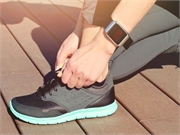Smartwatch EKGs Quickly Deliver Crucial Heart Data
By Alan MozesHealthDay Reporter

TUESDAY, Sept. 1, 2020 (HealthDay News) -- Could a smartwatch app save a heart attack patient's life? Quite possibly, according to Italian researchers.
They found that electrocardiograph (EKG) readings from a smartwatch were nearly as accurate as standard EKGs among patients with suspected heart attacks.
"A [standard] electrocardiograph is not always readily available," said study author Dr. Ciro Indolfi. "[So] the ability to identify an ongoing heart attack quickly and easily thanks to the use of a simple smartphone could be of great help in certain situations in reducing the negative consequences of a heart attack."
Indolfi is director of cardiovascular research at Magna Graecia University in Catanzaro, Italy.
An EKG is a graphic representation of the heart's electrical activity. Indolfi noted that these readouts are critical for establishing whether a patient with chest pain has had a heart attack. It can also quickly identify specific causes.
To see whether smartphone electrocardiograms actually work, researchers assessed EKG reliability among 81 patients who sought care for a likely heart attack at one clinic between April 2019 and January 2020. Two-thirds were men (average age: 61).
All received a standard "12-lead" EKG, which uses 12 electrodes at different spots on the chest and limbs to produce a reading.
Patients also had an EKG using the Apple Watch Series 4. The U.S. Food and Drug Administration has approved the smartwatch's built-in EKG tool as a reliable way to detect the serious heartbeat irregularity known as atrial fibrillation.
Instead of 12 electrode leads, the smartwatch is equipped with sensors designed to form a single electrode lead. As a workaround, researchers successively placed the watch in nine spots on each patient's body to generate multiple readings. The readings were then uploaded to an Apple iPhone.
For comparison purposes, 19 men and women who were not suspected of having experienced a heart attack also had standard and smartwatch EKGs.
Watch-generated EKGs were 94% accurate when it came to correctly identifying and distinguishing between various types of heart attacks, according to Indolfi. The watch also correctly noted that no heart attack had taken place in more than 9 out of 10 healthy patients.
The watch does not generate a diagnosis; the EKG readings need to be interpreted by a doctor. But the findings suggest that "with the Apple Watch it is possible to perform a nine-lead EKG with an almost similar reliability as the standard EKG," Indolfi said.
That's important, he added, because the faster post-heart attack treatments are administered, the better the outcome. That's especially true, Indolfi said, among patients who experience a very severe form of heart attack known as a STEMI (ST-segment elevation myocardial infarction).
Such patients can do well after insertion of a stent or a balloon (coronary angioplasty) to widen a blocked artery, Indolfi noted. But that procedure only "reduces mortality if it is performed promptly," meaning administering an EKG within 10 minutes and then, treatment within two hours.
Dr. Gregg Fonarow, director of the Ahmanson-University of California, Los Angeles Cardiomyopathy Center, welcomed the findings with cautious optimism.
"This new feasibility study shows that a smartwatch could be used to obtain multiple leads of an EKG," he said, underscoring the "high level [of] agreement" between smartwatch and standard readings.
Fonarow said more follow-up work will be needed to confirm the findings.
But he agreed that smartwatch EKGs could ultimately prove very helpful in speeding up diagnosis and treatment in situations where time is of the essence, including heart attacks in setting where standard EKGs are not available.
The findings were published in the Aug. 31 online edition of JAMA Cardiology.
More information
Learn more about electrocardiograms from the American Heart Association.

The news stories provided in Health News and our Health-E News Newsletter are a service of the nationally syndicated HealthDay® news and information company. Stories refer to national trends and breaking health news, and are not necessarily indicative of or always supported by our facility and providers. This information is provided for informational and educational purposes only, and is not intended to be a substitute for medical advice, diagnosis, or treatment.

